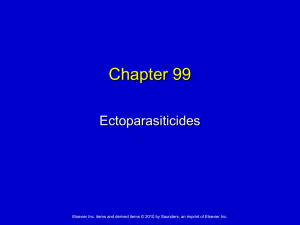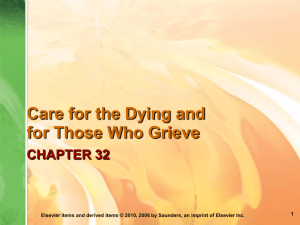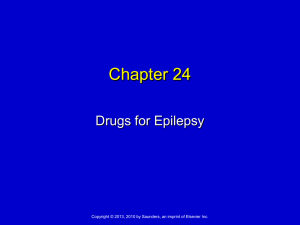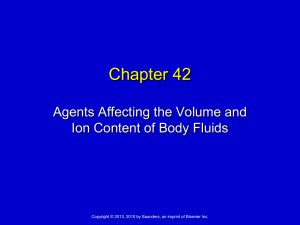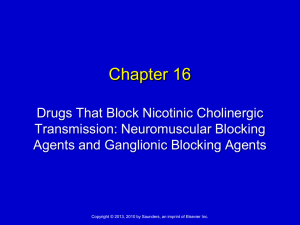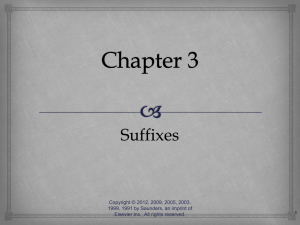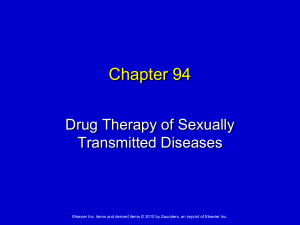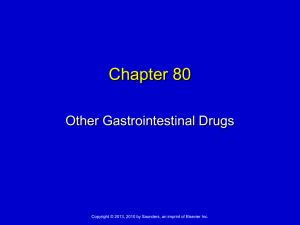Chapter Ten
advertisement
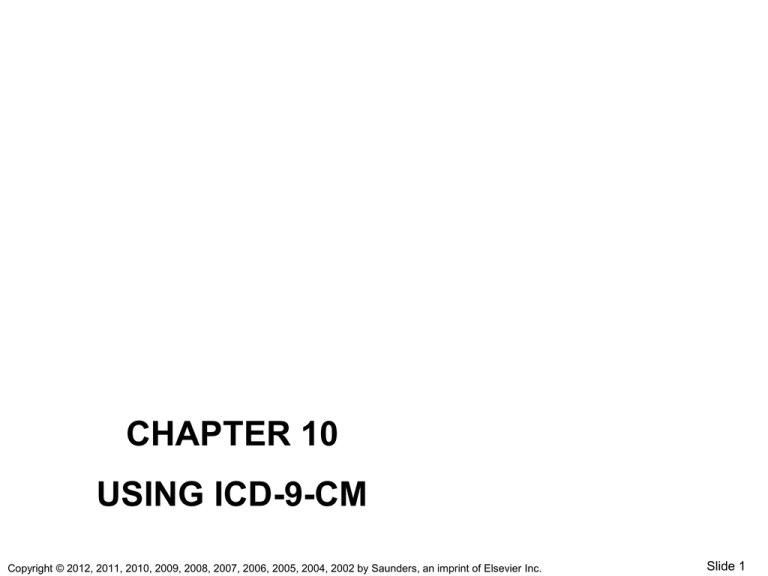
CHAPTER 10 USING ICD-9-CM Copyright © 2012, 2011, 2010, 2009, 2008, 2007, 2006, 2005, 2004, 2002 by Saunders, an imprint of Elsevier Inc. Slide 1 Using ICD-9-CM General Guidelines Chapter 1, Infectious and Parasitic Diseases Chapter 2, Neoplasms Chapter 3, Endocrine, Nutritional and Metabolic Diseases, and Immunity Disorders Chapter 4, Diseases of Blood and BloodForming Organs Chapter 5, Mental, Behavioral and Neurodevelopmental Disorders Chapter 6, Diseases of Nervous System and Sense Organs Chapter 7, Diseases of Circulatory System Chapter 8, Diseases of Respiratory System Chapter 9, Diseases of Digestive System Chapter 10, Diseases of Genitourinary System Chapter 11, Complications of Pregnancy, Childbirth, and the Puerperium Chapter 12, Diseases of Skin and Subcutaneous Tissue Chapter 13, Diseases of Musculoskeletal System and Connective Tissue Chapters 14 and 15, Congenital Anomalies; Certain Conditions Originating in Perinatal Period Chapter 16, Symptoms, Signs, and Ill-Defined Conditions Chapter 17, Injury and Poisoning and E Codes Basic Coding Guidelines ICD-10-CM Copyright © 2012, 2011, 2010, 2009, 2008, 2007, 2006, 2005, 2004, 2002 by Saunders, an imprint of Elsevier Inc. Slide 2 Using ICD-9-CM • Guidelines developed by cooperating parties • AHA (American Hospital Association) • AHIMA (American Health Information Management Association) • CMS (Centers for Medicare and Medicaid Services) • NCHS (National Center for Health Statistics) Copyright © 2012, 2011, 2010, 2009, 2008, 2007, 2006, 2005, 2004, 2002 by Saunders, an imprint of Elsevier Inc. Slide 3 General Guidelines • Appendix A of text contains link to access Official Guidelines for Coding and Reporting • Inpatient coders use Sections I-III of Guidelines • Outpatient coders primarily use Sections I. and IV., however… (Cont’d…) Copyright © 2012, 2011, 2010, 2009, 2008, 2007, 2006, 2005, 2004, 2002 by Saunders, an imprint of Elsevier Inc. Slide 4 General Guidelines (…Cont’d) • Basic coding guidelines do NOT cover all situations – Outpatient coders also use many inpatient guidelines Copyright © 2012, 2011, 2010, 2009, 2008, 2007, 2006, 2005, 2004, 2002 by Saunders, an imprint of Elsevier Inc. Slide 5 Steps to Accurate Coding • Identify MAIN term(s) in diagnosis • Locate MAIN term(s) in Index • Review subterms • Follow cross-reference instructions – (e.g., see, see also) • Verify code(s) in Tabular Copyright © 2012, 2011, 2010, 2009, 2008, 2007, 2006, 2005, 2004, 2002 by Saunders, an imprint of Elsevier Inc. Slide 6 Remember • Read Tabular notes • Code to highest specificity (detail) • NEVER CODE FROM INDEX! Copyright © 2012, 2011, 2010, 2009, 2008, 2007, 2006, 2005, 2004, 2002 by Saunders, an imprint of Elsevier Inc. Slide 7 Guideline Section I.B.3. Level of Detail in Coding • Assign diagnosis to highest level of specificity – Do NOT use three-digit code if there is fourth – Do NOT use four-digit code if there is fifth • If not specific, claims bounce! Copyright © 2012, 2011, 2010, 2009, 2008, 2007, 2006, 2005, 2004, 2002 by Saunders, an imprint of Elsevier Inc. Slide 8 Guideline Section I.B.7. Conditions integral to disease • Signs and symptoms that are associated routinely with a disease process should not be reported separately, unless otherwise instructed in the classification • Example: – Fever and shortness of breath due to pneumonia – Report only Pneumonia 486 Copyright © 2012, 2011, 2010, 2009, 2008, 2007, 2006, 2005, 2004, 2002 by Saunders, an imprint of Elsevier Inc. Slide 9 Guideline Section I.B.8. Conditions NOT integral to disease • Additional signs and symptoms not routinely associated with disease process should be reported • Example: – Dehydration due to pneumonia – Report • Pneumonia and • Dehydration Copyright © 2012, 2011, 2010, 2009, 2008, 2007, 2006, 2005, 2004, 2002 by Saunders, an imprint of Elsevier Inc. Slide 10 Section I.B.9. Multiple coding for a single condition • Etiology (cause) • Manifestation (symptom) – Slanted brackets [ ] – Example: Retinopathy, diabetic 250.5 [362.01] • Code as shown – 250.5X – 362.01 (Cont’d…) Copyright © 2012, 2011, 2010, 2009, 2008, 2007, 2006, 2005, 2004, 2002 by Saunders, an imprint of Elsevier Inc. Slide 11 Section I.B.9. Multiple coding for a single condition (…Cont’d) • Must check Tabular notes to assign correct fifth digit for diabetes • Tabular: 362.0, Diabetic retinopathy, instructs to “Code first diabetes 250.5” – 250.5X Cause is diabetes – 362.01 Manifestation is retinopathy • Report 250.5X, 362.01 – X = required additional digit Copyright © 2012, 2011, 2010, 2009, 2008, 2007, 2006, 2005, 2004, 2002 by Saunders, an imprint of Elsevier Inc. Slide 12 Section I.B.10. Acute and Chronic Conditions • Exists alone or together • May be separate or combo codes • Reporting both codes, code acute first (Cont’d…) Copyright © 2012, 2011, 2010, 2009, 2008, 2007, 2006, 2005, 2004, 2002 by Saunders, an imprint of Elsevier Inc. Slide 13 Section I.B.10. Acute and Chronic Conditions (…Cont’d) • Example, acute and chronic pancreatitis • When two separate codes exist, code: – Acute pancreatitis 577.0 – Chronic pancreatitis 577.1 • Place acute first and chronic second – 577.0, 577.1 (Cont’d…) Copyright © 2012, 2011, 2010, 2009, 2008, 2007, 2006, 2005, 2004, 2002 by Saunders, an imprint of Elsevier Inc. Slide 14 Section I.B.10. Acute and Chronic Conditions (…Cont’d) • Combination code: Both acute and chronic condition • Diarrhea (acute) (chronic) 787.91 • Acute and subacute bacterial endocarditis 421.0 • Otitis acute and subacute 382.9 Copyright © 2012, 2011, 2010, 2009, 2008, 2007, 2006, 2005, 2004, 2002 by Saunders, an imprint of Elsevier Inc. Slide 15 Section I.B.11. Combination Code • Always use combination code if one exists – Example, encephalomyelitis (manifestation) due to rubella (etiology), 056.01 • Assign only when code fully identifies condition Copyright © 2012, 2011, 2010, 2009, 2008, 2007, 2006, 2005, 2004, 2002 by Saunders, an imprint of Elsevier Inc. Slide 16 Section I.B.12. Late Effects • Ex., 701.4 followed by code 906.6 • Late effect is a residual of (remaining from) previous illness/injury – e.g., Scar produced by previous burn • Residual coded first (scar) • Late effect cause (burn) coded second, 906.6 • No time limit • Generally requires 2 codes (Cont’d…) Copyright © 2012, 2011, 2010, 2009, 2008, 2007, 2006, 2005, 2004, 2002 by Saunders, an imprint of Elsevier Inc. Slide 17 Late Effects (…Cont’d) • Late effect codes not in separate chapter – Rather throughout Tabular • Reference the term “Late” in the Index • There is no time limit on developing a residual • There may be more than one residual – Example: Patient had a stroke and has residual paralysis on dominant side (hemiparesis, 438.21) and aphasia, 438.11 • Late effect means the original injury has healed and you are dealing with a “residual” condition Copyright © 2012, 2011, 2010, 2009, 2008, 2007, 2006, 2005, 2004, 2002 by Saunders, an imprint of Elsevier Inc. Slide 18 Section I.C.7.d. Late Effects of Cerebrovascular Disease • 438 indicates conditions classified to 430437 as causes of Late Effects • Code V12.54 – Assigned for TIA and cerebral infarction without residual deficits – Do not report from category 438 Copyright © 2012, 2011, 2010, 2009, 2008, 2007, 2006, 2005, 2004, 2002 by Saunders, an imprint of Elsevier Inc. Slide 19 Conclusion CHAPTER 10 USING ICD-9-CM Copyright © 2012, 2011, 2010, 2009, 2008, 2007, 2006, 2005, 2004, 2002 by Saunders, an imprint of Elsevier Inc. Slide 20


